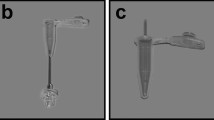Abstract
Using high performance liquid chromatography (HPLC) the tear protein profiles were measured in controls, patients with Sjögren's disease, questionable dry eye (idiopathic dry eye), idiopathic chronic conjunctivitis and the corneal melting syndrome.
Qualitative comparison of the protein profiles of patients with Sjögren's disease, corneal melting and IgA deficiency shows a marked difference in the heights of various peaks as compared to the profiles of the control group. The total protein content of tears in controls and in patients with idiopathic chronic conjunctivitis is age dependent and appears to increase until the age of 40 and to decrease afterwards. The peaks containing IgA, lactoferrin and lysozyme were measured in various eye diseases. In idiopathic chronic conjunctivitis and in the corneal melting syndrome no differences were seen in comparison with controls. In patients with idiopathic dry eye and Sjögren's disease a marked decrease in the three proteins was seen. The study presented here indicates that the HPLC analysis of tears is a promising technique which may increase our knowledge of this ocular fluid.
Similar content being viewed by others
References
Haeringen NJ van. Clinical biochemistry of tears. Surv Ophthalmol 1981; 26:84–96.
McGill JI, Liakos GM, Goulding N, Seal DV. Normal tear protein profiles and age related change. Br J Opthalmol 1984; 68:316–320.
Jansen PT, Bijsterveld OP. Pathophysiology of the tear film: protein patterns in health and disease. In: Marquardt R, ed. Chronic conjunctivitis - Trockenes Auge. Wien, New York: Springer, 1982; 73–87
Berta A. Standardization of tear protein determinations: The effects of sampling; flow rate and vascular permeability. In: Holly FJ, ed. The preocular tear film in health disease and contact lens wear. Lubbock, Texas: Dry Eye Inst Inc, 1986; 418–435.
Tapasztó I. The characteristic features of the variations of the proteins of human tear. In: Holly FJ, ed. The preocular tear film in health, disease and contact lens wear. Lubbock, Texas: Drye Eye Inst Inc, 1986; 436–461.
Inada K, Baba H, Okamura R. Studies of human tear proteins -1: Analysis of tears from normal subjects by crossed immunoelectrophoresis. Jpn J Opthalmol 1982; 26: 314–325.
Boonstra A, Kijlstra A. Separation of human tear proteins by high performance liquid chromatography. Curr Eye Res 1984; 3: 1461–1469.
Inada K, Baba H, Okamura R. Studies of human tear proteins -2: Analysis by crossed immunoelectrophoresis of tears from diseased eyes. Jpn J Ophthalmol 1983; 27: 277–288.
Mackie IA, Seal DV. Diagnostic implications of tear protein profiles. Br J Ophthalmol 1984; 68: 321–324.
Zavaro A, Samara Z, Baryshak R, Sompolinsky D. Proteins in tears from healthy and diseased eyes. Doc Ophthalmol 1980; 50: 185–199.
Jones LT. The lacrimal secretory system and its treatment. Am J Ophthalmol 1966; 62: 47–60.
Jansen PT, Bijsterveld OP. The relations between tear fluid concentrations of lysozyme, tear specific prealbumin and lactoferrin. Exp Eye Res 1983; 36: 773–779.
Pierce J, Suelter C. An evaluation of the Coomassie brilliant blue G 250 dye binding method for quantitative protein determination. Anal Bioch 1977; 81: 478–480.
Ballow M, Donshik PC, Papacz P, Samartinol. Tear lactoferrin levels in patients with external inflammatory ocular disease. Invest Ophthalmol Vis Sci 1987; 28: 543–545.
Fullard RJ, DeLucas LJ, Crawford TS. HPLC Analysis of proteins in human basal and reflex tears. In: Holly FJ, ed. The preocular tear film in health, disease and contact lens wear. Lubbock, Texas: Drye Eye Inst Inc, 1980; 482–505.
Gachon AM, Lambin P, Dastugue B. Human tears: electrophoretic characteristics of specific proteins. Ophthalmic Res 1980; 12: 277–285.
Author information
Authors and Affiliations
Rights and permissions
About this article
Cite this article
Boukes, R.J., Boonstra, A., Breebaart, A.C. et al. Analysis of human tear protein profiles using high performance liquid chromatography (HPLC). Doc Ophthalmol 67, 105–113 (1987). https://doi.org/10.1007/BF00142704
Issue Date:
DOI: https://doi.org/10.1007/BF00142704




